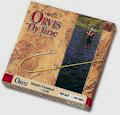Flyfishing for Trout and Grayling
Introduction - Conservation - Tackle - Trout Flies - Fishing Techniques - Casting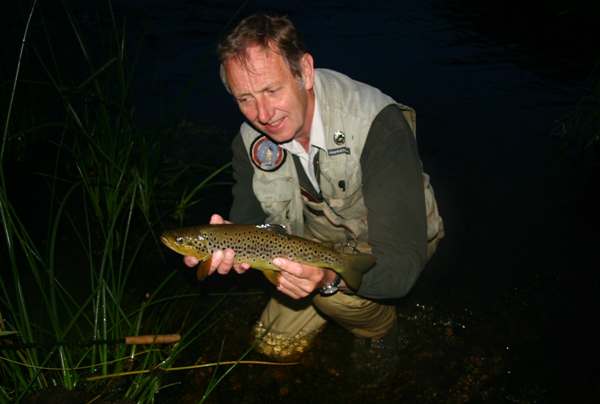
Every year new books are published about flyfishing, new fly rods (far better than anything that has ever gone before!) are marketed, new fly lines are invented, and new 'killer' flies are designed and sold in their thousands. The impression is that this is such a difficult, complicated and challenging pastime that constant innovation, and therefore constant expenditure, is required to enable us to do it better. Although there is no disputing that modern fly rods are much lighter, stronger and easier to use than the cane rods of yesterday, and that modern fly lines make is much easier for beginners to cast, flyfishing for trout and grayling can be as complicated and expensive or as simple and inexpensive as you choose to make it. You can have as much fun fishing on small mountain streams as you can on an expensive trip to catch monster fish in far flung destinations. You can easily catch fish with a selection of seven flies rather than the seven thousand that fishing shops would have you believe are vital to success; and, chosen carefully, one fly rod is usually all you need to fish in most places on rivers or lakes.
The Key to Success
The things that make the most difference to success in flyfishing are not the tackle, not the expensive clothing and accessories but your own knowledge and skill: the knowledge of how and where to fish in various conditions and at different times of the year, and the skill to enable you to be able to cast delicately and accurately in the kinds of places where the best fish live and feed.
Wild Trout Conservation
In many rivers the stocks of wild brown trout (Britain's native trout) are seriously depleted, and conservation action is essential if we are not to lose them altogether but instead want the rivers to recover. Caring flyfishers do not kill wild trout; instead they return them safely to the river with the minimum of delay and handling. Please see our guidelines on best practice catch and release and our online length-to-weight converter.
Flyfishing Tackle for Trout and Grayling Fishing
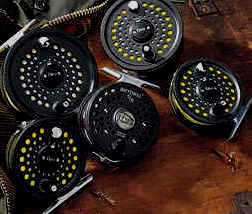
Thinking of taking up flyfishing? The good news is that kitting out can be much less expensive than for most other sports. For less than £150 you can get a very good flyfishing outfit - a set-up that out-performs 95% of the outfits in use today... but only if you buy wisely.
In the advice presented here, (J-B) indicates a link to our Jargon-Buster page of plain English explanations of technical terms.
How long does flyfishing tackle last?
Flyfishing lines and nylon leaders (J-B) have limited lifetimes - a line will probably last you between two and five years, and leaders are inexpensive and best replaced every year. But with very little attention the other items in your flyfishing outfit should last a lifetime.
Quality or quantity?
You might have thought that price is a guide to quality. Certainly it is rare to find high-priced tackle that is unusable, whereas more of the so-called 'beginner outfits' turn out to be a bitter disappointment. But, just as an example, did you know that it is perfectly possible to pay £500 for an outfit and have no more than a 12 month guarantee? And yet for just £140 you can get a balanced rod, reel and fly line set-up with a 25-year guarantee, giving you high quality of and world-class customer service. As it happens both outfits in this example are a delight to use... but I know which one would give me greatest peace of mind. (Come to think of it, isn't peace of mind one of the main reasons we go fishing?)
Fly fishing does not require a lot of tackle, but whether you decide on a budget outfit or a top-grade set-up it pays go for quality - kit that works well from day one and goes on doing so reliably. You also need a balanced outfit: a fly line that suits the kind of fishing you intend doing, and a rod and reel that are properly matched to that fly line.
Will one outfit do for everything?
The simple answer is yes... and no, of course. It is just possible to fish for wild trout on a moorland stream with the same rod you use for reservoir trout, for sea trout and the occasional salmon. But if small streams become your main interest you will almost certainly wish you had a lightweight brook rod with a light line, fine nylon leaders (J-B) and tiny flies that match the hatch (J-B) of insects. Such an outfit is useless for salmon, but at a push you could fish on lakes and reservoirs for trout, accepting that you would have a real battle on your hands if a five pounder took your fly.
A powerful reservoir rod, on the other hand, would be ideal for grilse (small salmon that run up rivers in summer) and would give you a reasonable chance of landing anything other than a very big salmon. It would, of course, be far too stiff for small stream trout fishing.
So what about a mid-way compromise? That's what most flyfishers are very happy with, at least for their first two or three seasons (and many people find no need for anything more). Such an outfit will allow you to fish on tiny moorland streams, although not with the very smallest of flies and the finest of nylon leaders (J-G); it is ideal for tackling the trout of most stocked trout pools and chalk streams; and it also gives you at least a fighting chance if you go spate river fishing and you hook a grilse or a summer sea trout. Don't use it to try for spring salmon and sea trout, which although quite scarce are usually too big and powerful for such an outfit.
A general-purpose flyfishing outfit
Here, then, is a suggested beginners' outfit. Although inexpensive, it could last a lifetime if looked after carefully.
Item |
Description |
Guide Price |
Line |
WF6F. This is the code for a weight-forward floating line rated AFTMA #6. (This is a shorthand way of saying a 6-weight floater with what is called a weight-forward profile. Confusing? See our Jargon-buster page for more details.) A floating line is the easiest to manage and the one that most trout fishers use most of the time. Smoothness of surface, freedom from 'reel memory' (J-B), and durability are characteristics of a good quality fly line. | £40-00 |
Reel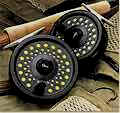
|
The reel is simply a place to store the line; but beware of very cheap plastic reels where so often the mechanism jams just as you are trying to land a really good fish. A good reel will last a lifetime if you keep it clean (free from sand and other gritty material) a grease the bearing surfaces periodically. | £35-00 |
| Backing | 175 yards of 20 lb breaking strain backing (J-B). Backing line should be almost entirely free of reel memory (J-B), particularly if you are casting beyond the length of the fly line itself. | £10-00 |
Rod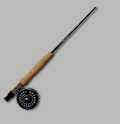 |
A 9-foot, 2-piece rod intended to cast a 6-weight line is long enough to allow you to fish over bank-side vegetation but light enough to handle fine nylon leader tippets (J-B) and small flies when 'matching the hatch' (J-B) is necessary. We use Sage rods and find them excellent. But many other manufactures now produce great rods, so whatever your budget you should be able to find a rod that performs well. Before buying a rod, if at all possible try casting with it to see how you get on. |
£150-00 |
| Rod tube | A strong plastic tube to protect the rod when in transit... the cloth bag alone provides nowhere near enough protection. We have made perfectly adequate tubes using kitchen sink waste pipe, with a solvent-welded fixed cap at one end and a screw-cap fitting at the other end; the cost then is little more than £5. |
£25-00 |
What else will I need?
Accessories and gamefishers' clothing make ideal Birthday and Christmas Present, so why not drop a few hints... but not too subtle. You will want flies, boxes to keep them in, nylon leaders and tippet nylon, floatant and sinkant (stuff to make flies float and other stuff to make nylon sink)... and so on. Landing net, waders, fly tying tools and materials - the list is not quite endless and very few are absolutely essential. All you really need are your basic outfit, a few flies and some nylon for making leaders; the rest can come later (or not at all).
Our advice is to keep it simple: a well-balanced rod, reel and line, a nylon leader and seven flies - the Magnificent Seven (J-B) of course - and you are kitted out for flyfishing.
More about fly reels
The fly reel acts as a reservoir for line, which can be stripped off in preparation for casting, paid out under tension when playing a fish, and retrieved while fishing. The spool size of the reel should comfortably accommodate the chosen fly line and at least 50 yards (about 50 metres) of backing. If you are going to be fishing in a variety of places which require different types of fly line - floating or sinking lines, for instance, it is sensible to buy spare spools so that the lines can be changed with the minimum of inconvenience. The lightest reels are made from magnesium, which is expensive, whereas plastic, carbon fibre or aluminium reels are much cheaper. Reels should be well engineered and robust; and, when choosing a reel, it is important to ensure that the spool is the right size to comfortably accommodate the chosen fly line. Most people choose a single action reel which, for each turn of the handle, turns the spool once; they are available either with the spool enclosed or with its rim exposed. An exposed rim is useful because it allows you to control the line tension when playing a fish.
A check mechanism controls the passage of the line from the reel, preventing the reel from offering the line too fast when a fish is ‘running’. Most reels have an audible ratchet system. More expensive reels often have a disc brake system, which gives greater control of the line tension. Multiplying reels are geared to retrieve line faster, usually working on a two-to-one ratio, but the internal mechanisms are more complicated and require more maintenance.
More about fly rods
The carbon fly rod of today fulfils the same role as the glass fibre, cane or greenheart rods of the past. Cane rods, which are still being produced, are length for length the heaviest but can still deliver a fly accurately and delicately in the right hands. Tubular glass fibre revolutionised fly rod design with its lightness; it has now been superseded by carbon fibre. Carbon fibre rods are lighter, thinner and stronger. As an indication of the weight of fly line they are capable of casting, modern rods are marked with their AFTM (Association of Fishing Tackle Manufacturers) rating. A rod marked AFTM 5 (often shortened to just #5) is designed to be fully loaded, and hence to cast best, with 10 yards of AFTM 5 fly line extended beyond the rod tip. A shorter length of heavier line would achieve the same loading, and a longer length of lighter line could achieve the same purpose. A marking of AFTM 4–6 indicates that the rod would be fully loaded by 10 yards of AFTM 6 line extended beyond the rod tip or by a longer length of the lighter #4 line. Beginners should choose a line of the heaviest rating marked on the rod.
As a general rule the shorter the distance to cast the shorter the rod required. An ideal chalk stream rod would be 7 to 8 ft in length and AFTM 4/5 rated. Longer and heavier rods would be used for fishing on large stillwaters or reservoirs - 9 to 10 feet in length and AFTM rated 7/8. A good 'all-rounder' would be a 9ft AFTM 6 with, which a Weight Forward (WF) line of the same AFTM rating, could be used for either lakes or rivers.
Fast action or tip action
These rods are suited to shooting heads and weight forward lines (see below) for distance casting on reservoirs. They are also useful for long-range dry fly and nymph fishing on still waters and for fishing on big rivers where both accuracy and distance are important.
Middle to tip action
This is a useful all-round rod, especially for the newcomer to fly fishing. Managed properly it can cast over 20 metres (65 ft) but at short range it is still both delicate and accurate. When playing a fish the flexible upper section acts as a shock absorber.
Through action
This rather specialist rod bends throughout its length. It is good for short-range loch style fishing and for presenting a dry fly or a nymph delicately on small streams. The gentle action is reminiscent of cane rods.
More about fly lines
The fly line provides the weight necessary to load the rod when you are casting. A tapered profile at the front part of the fly line ensures that the fly is presented accurately and delicately. Lines are available in a range of profiles, weights and densities defined by AFTM codes such as DT7F and WF6I.
Line profile
The first two letters of the AFTM code classify the line as either double tapered (DT), weight forward (WF), or shooting head (SH) - also known as shooting taper (ST). Lines taper in towards the tip to provide a smooth transmission of energy down the leader. DT lines are still quite popular and have the advantage that when one end becomes worn the line can be turned around and the other end used for casting. The WF line is easier to cast a long distance, while its front taper, which has the same profile as that of a DT line, allows delicate short-range presentation on both rivers and still waters. SH Lines are mainly used for long distance casting, especially on still water, but you will need to master the double haul casting technique to get full advantage from this kind of line.
Line weight
Line weight is measured over the first 9.1 metres (30 ft.) of line excluding the front 60 cm (2 ft.) of level line. Lines of #3, #4 and #5 are ideally suited to river flyfishing using small flies. #6 is a good all-round weight, being able to cope with a variety of fishing tactics. Lines rated #7 and #8 are more suitable for reservoir fishing and casting flies on fast-flowing rivers. #9 and #10 shooting heads are the preserve of specialist tactics.
Line density
The final letter or letters of the AFTM code denote whether a line is floating, sinking, sink tip or intermediate. A floating line (F) is probably the most versatile, being suitable for dry flies, nymphs, wet flies and streamer flies on still or running water; it can be lifted from the water and aerialized easily. Deep water may require the use of sinking lines (S). A range of densities, giving different sink rates, allows various tactics on still waters and rivers. When recasting using a sinking line, it is advisable first to roll cast to bring the line up to the surface; this will avoid the risk of overloading and perhaps breaking the rod tip. A sink tip line – for example WF7ST - is a floating fly line with a short, sinking forward section. It is most commonly used on rivers and is more difficult to cast because of the differing densities of the floating and sinking sections. An intermediate line, such as DT8I allows the fly to be fished just subsurface on either river or still water; it is, in effect, a very slow sinker.
Line colour
Line colour affects its visibility in different light conditions, and in some circumstances it can also affect the fish. Floating lines tend to come in light hues, such as pale blue, ivory, peach and even florescent tones of yellow, orange or green. In many instances they enable easier tracking of a fly, especially in low light, yet they may spook trout when fished in clear water against a dark background; therefore, some people suggest that dark coloured floating lines may also have a role to play. (We have found no need for a dark floating line.) Sinking lines are usually either translucent or made in dark colours that blend with underwater weeds, rocks and gravel.
More about leaders
The leader is the fine, low-visibility connection between the fly line and your artificial fly. Here are details of some of the many options available.
Tapered leaders
Tapered leaders are essential. Never fish a dry fly, a nymph or a small wet fly using a level leader; it simply wonlt work! The best types of leaders taper continuously to a fine ‘point’ or ‘tippet’, helping you to cast the fly better. Whether you make your own leaders or buy knotless tapered leaders from a tackle shop, the strength of the point is important. Nylon is rated by its breaking strain (b.s.) in kilograms (pounds) and its diameter in millimetres (inches). For river flyfishing you will often need to use a lighter point strength than for still water fishing. The length of the leader is also important because it is this that distances the fly from the thick and more visible fly line. A recommended length of leader for rivers is 2.7 to 3.3 m (9 to 12 ft). Still water fishing often demands longer leaders of 3.3 to 6.5 m (12 to 24 ft).
Braided butts
A 1 to 1.5 m (3 to 5 ft.) length of tapered, braided nylon can be used between the leader and fly line to ensure smooth transfer of power from line to leader and so improve the fly presentation. There are, however, two disadvantages with the use of braided butts: the means of attachment to the fly line can sometimes cause the line to ‘hinge’ and break, and the braided section can also splash when landing on the water and so frighten fish. Many anglers prefer to use a length of heavy-duty nylon connected to the fly line with a needle knot, nail knot or loop-to-loop connection; this not only helps with delicacy of casting but it is also less likely to alarm the fish.
Droppers
You can make up your own leaders to incorporate droppers. The droppers should be 10 to 15 cm (4 to 6 in.) long, because longer droppers tend to tangle. Space the droppers along the leader and tie them in using the water knot.
Trout Flies - How to Choose and Use Them to Best Effect
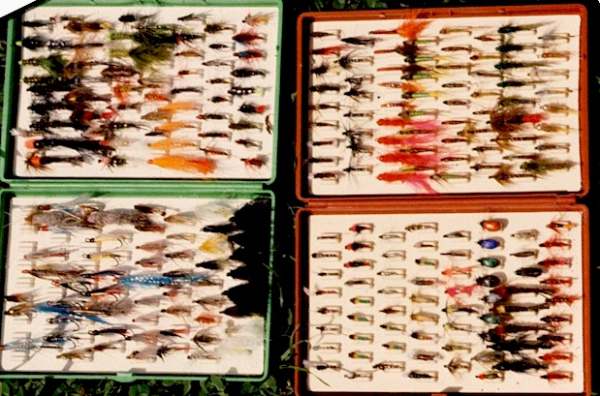
Regardless of whether you fish mainly on small well-stocked put-and-take lakes, chalk streams, wild spate rivers or vaste reservoirs and natural lakes, the one piece of advice we urge you to follow on the topic of flies is this: you do not need many different patterns.
You will need flies of different types and various sizes, but having dozens of patterns is a hindrance rather than a help.
Trout flies are generally described either as being dry flies, nymphs, or wet flies. Dry flies are designed and tied in such a way that they float on the surface of the water and immitate adult insect species. Wet flies are those that sink below the surface and can be made to move like small fish. Nymphs immitate the larvae or pupae of insects.
In Matching the Hatch, Pat gives details of his 'Magnificent Seven' - all the flies a beginner needs, and a small enough number to make choosing the fly something you can do with confidence. For advanced trout fishers the book also contains The Deadly Dozen, and they are a wonderful but still very concise set of flies that really will cope with just about every situation. The truth is, however, that in 95 per cent of our own trout fishing, all over the world, we have been able to select a suitable fly from within 'The Magnificent Seven'. We hardly ever use anything else...
Dry fly
A dry fly is one that floats on the surface. Hackles help achieve this and so can tails. Dry flies can represent adult insects such as mayflies, caddisflies (also known as sedge flies), stoneflies and midges; they could equally well be designed as artificial spiders, grasshoppers and other terrestrial creatures.
Modern styles of tying can imitate an insect set either in the surface film or sitting upon the surface of the water. Light dressings (using a minimum of tying materials to represent tails, bodies, wings and legs) are appropriate for calm water in which flies are just hatching, whereas well-hackled flies, sometimes incorporating hair, float better in rough, fast water from which insects may be taking off.
Wet Fly
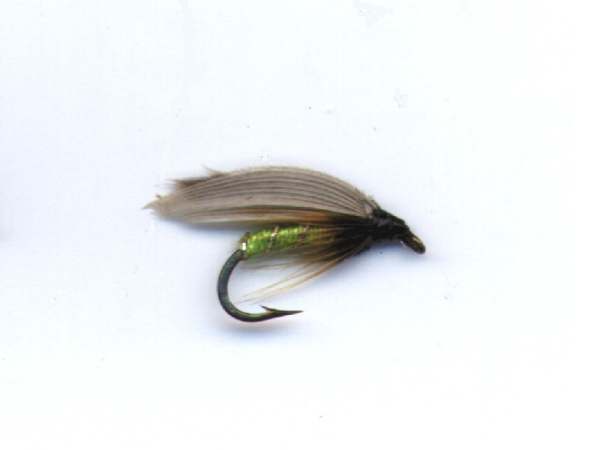
In its simplest form, a wet fly comprises a slim body, with or without wings, and a few turns of soft hackle. It is designed to sink below the surface and may represent a small fish or even an aquatic fly emerging from its nymphal or pupal shuck.
Wet flies are ideal for loch-style fishing from boats, and they can also be fished in teams (using one or more often two or three droppers with a wet fly attached to each) on fast flowing streams.
Nymph
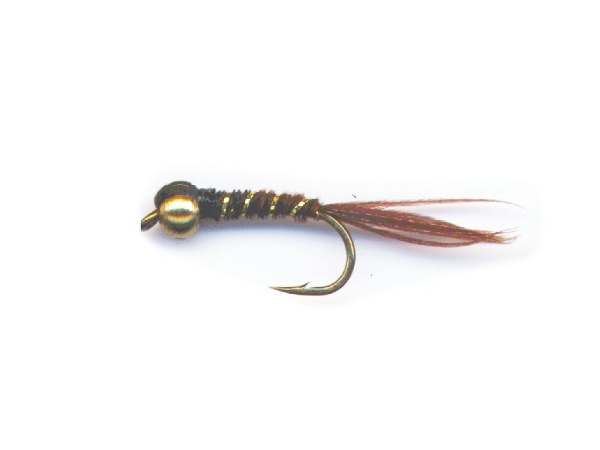
A nymph is an artificial representation of a particular natural aquatic insect form. The term nymph is sometimes used loosely to cover various larvae and pupae as well as mayfly and stonefly nymphs, and crustaceans such as the fresh water shrimp and the water slater or hoglouse. Nymphs can be weighted or unweighted so that various fishing depths can be reached, ranging from the lake or river bed (weighted) to just below the surface (unweighted). Some are even buoyant and simply float in the surface film.
Streamer Fly, or Lure
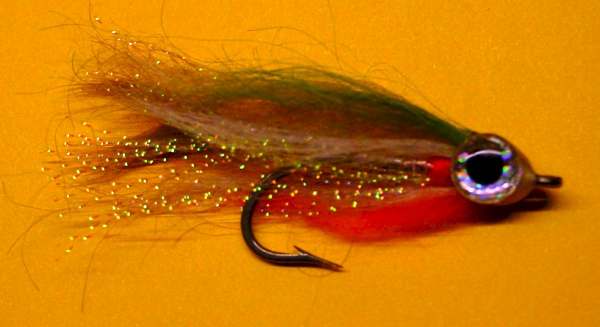
Streamers are basically elongated wet flies and can be divided into two distinct categories. The first is the attractor which, while not imitating any particular food form, appeals to the trout through its colour, movement, flash or a combination of these. The second is the imitator of small fish. Streamers are often weighted and are fished on either sinking, sink tip or floating lines depending on the conditions and the depth at which trout are feeding. Most lures bear little resemblance to any aquatic insect. When fished in the murky depths of a reservoir they could easily be mistaken for small fry, particularly if the line is retrieved with a jerky movement so that the antics of the lure suggest the laboured swimming of an injured fish.
When there are no insects hatching from the surface of the water, streamer flies can be very effective indeed.
Flyfishing Techniques and Tactics for Trout and Grayling
Many of us start fishing on stocked ponds or lakes for Rainbow Trout or occasionally stocked Brown Trout. Such places are perfect for beginners unhampered as they normally are are by high banks or trees immediately behind where you are trying to cast, and also without the added requirement of managing a flyline and fly in a fast-moving current. Stocked fish are also generally easier to catch, having been raised in highly protected hatchery areas with no need to learn the hard way, as wild fish must do, to avoid the numerous predators they encounter in wild rivers and lakes.
Wild fish are different
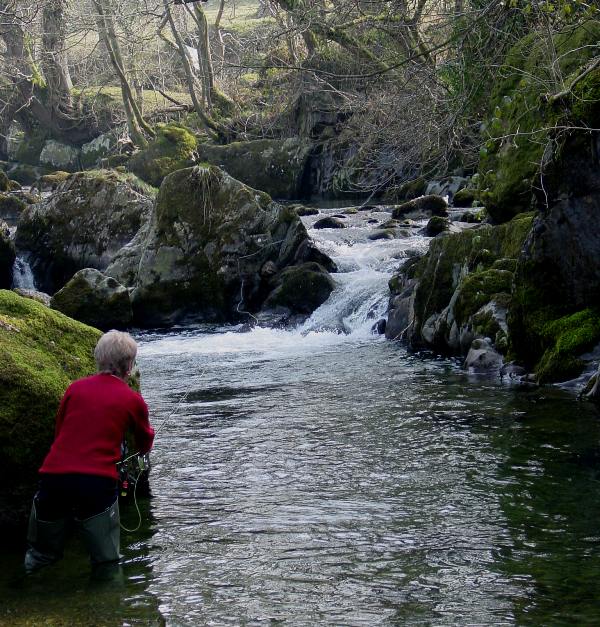
Moving on from stocked ponds to fish for wild trout in rivers is a huge right of passage for most of us and requires much grit and determination. There is the wading to take into account along with the problems of casting to rising fish which are holding station in often fast-moving water - unlike our flies which, even cast accurately to a rising fish, stay within the fish's vision range for a split second before being whisked away from it by the current.
As if mastering these difficult conditions are not enough there is also the question of where to cast, especially if there are no visible fish. This is called 'reading the river', and unlike casting which can be learned by a diligent person in a few months, learning where and how to fish a wild river is an ongoing learning exercise and one which only the rivers that we fish and the fish that we catch (or not!) can teach us.
Wild fish are all cowards, and the bigger they are the more cowardly they have been, and still are. They do not grow older and larger by hanging around to check whether or not the sudden movement above them is an incompetent angler trying to cast or a heron! Not only does this mean that we must behave and move with the utmost stealth and caution, but also that we must gain an understanding of how fish live and behave in order to survive.Fooling a wild fish into taking a dry fly must surely be one of the most challenging, exhilarating and satisfying fishing prizes of all.
Below are some basic tactical considerations when fishing rivers and lakes which should help you to get started on the road to being able to read the river or lake and to fish them more successfully.
Spate river tactics
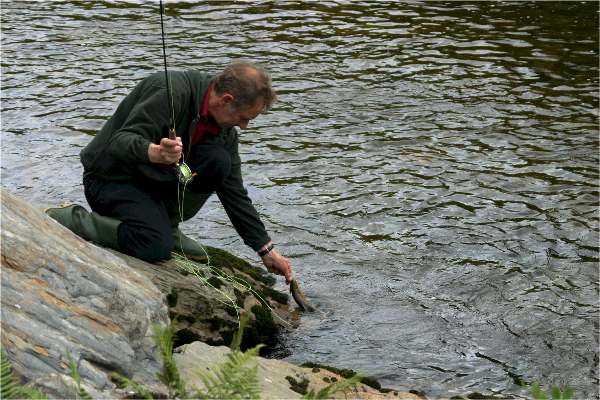
A spate river is a challenging environment both for fish and for anglers. The water is subject to frequent fluctuations in height, colour, flow and temperature, and all these factors must be considered when fishing.
For the flyfishing beginner it is best to avoid the calm, slow stretches of rivers and streams, where casting accuracy and presentation of the fly are critical in order to avoid alarming the fish. Instead, start with fast-flowing ‘riffles’ and the necks and tails of pools, where turbulence makes the fish’s vision fragmented and less clear, disguising the presence of the angler and making splashy attempts at casting less obvious. Other good places to fish are the food lanes, which can easily be identified by looking for lines of bubbles or scum on the surface of the water. Back eddies where food and bubbles are collected and swirl in circles can also prove very productive.
Look for places with good natural cover offering protection to the fish from their many predators such as herons and other fish-eating birds. These places are always worth a try, although acquiring the skill necessary to cast under low-hanging branches and bushes will take time. It is important to remember that on calmer stretches of water the first cast is nearly always your best chance of catching a fish.
Chalk stream tactics
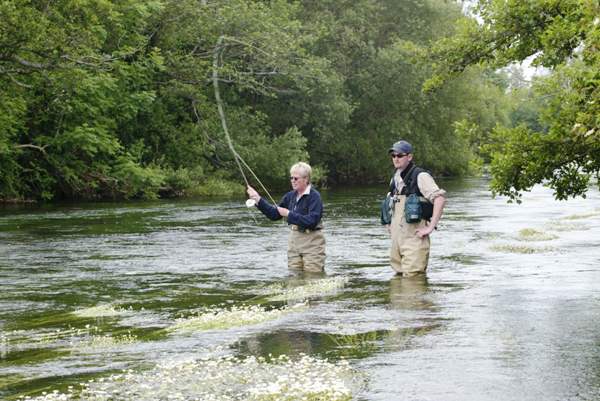
It is all too easy to misread the meandering waters of chalk streams, where trout can frequent any number of subtle lies that are often overlooked by anglers. Many of these areas are located hard against the riverbank, especially where reeds, tall grass or irises overhang. Other more obvious locations are subsurface weed beds, channels and areas of debris as well as collected weed around bridge pillars. The overall depth of chalk streams does not vary as dramatically as in rain-fed rivers.
The water clarity of chalk streams can present quite a problem: the fish can see us just as clearly as we can see them - and sometimes from a considerable distance. When fishing clear waters, the way in which you present yourself can be of great importance.
To stand upright, dressed in bright colours, or even to approach the riverbank too quickly can invite disaster. Ideally, your clothing, and most definitely your behaviour, should harmonise with the surroundings. In these circumstances it is also advisable to keep low down if wading (although note that wading is not allowed on many chalk stream beats) or to crouch or kneel when fishing from the bank.
Shadows cast suddenly across the stream can cause wild fish to flee for cover. Try to fish from a position that keeps your shadow off the water. If this is not possible, kneel down to minimise your shadow. High-gloss rods and reels can also reflect the sun and scare trout, as can brightly coloured fly lines flashing against a dark background.
Stillwater Tactics
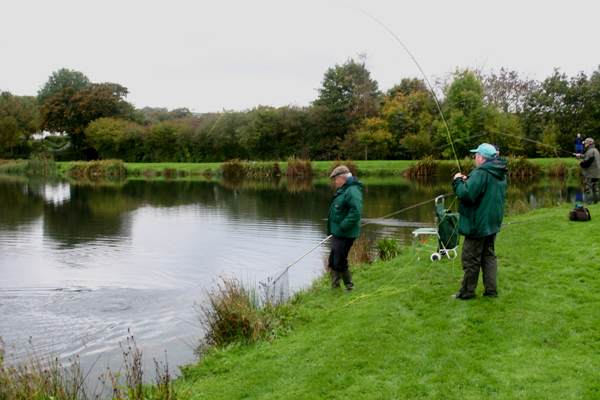
Stillwater fisheries are great places to learn to fish. Most of the surface food available to trout in lakes is, as on rivers, seasonal. The transitions between seasons are gradual, and therefore the hatches of many insect species overlap the change from one season to another. For example, on rivers the Large Dark Olive of springtime also appears in autumn; that is because it hatches throughout the colder months of autumn, winter and spring.
Several of the stillwater food creatures available in reasonable quantities throughout the year tend to spend all or most of the time below the water’s surface. Knowing which fly to use, however, is only part of the story; it is equally important to know where and how to use it. Sub-surface food is particularly hard to locate and does not necessarily follow the same route as the surface food lanes on rivers or the wind lanes on still waters. Submerged insects can also relocate to different areas of a lake at different times of year.
Although there is at least some food available to trout at all times, it is important to remember that the appetite of a fish varies considerably with changes in water temperature. In spring and autumn, a trout will normally feed more avidly than in summer when the water temperature may be above the optimum for a comfortable existence. Within the range of 10 to 17 degrees Celsius most trout feed well. When the temperature rises above 18 degrees Celsius, brown trout lose their appetites. Rainbow trout will tolerate about two degrees higher than this before they also become distressed due to oxygen starvation and they then also stop feeding.
Low temperatures have a similar effect. Trout feed very little once the water temperature drops below six degrees Celsius. Although they are able survive for long periods at temperatures just above freezing, in these conditions trout become torpid and rest on the bottom, hardly moving at all.
The tactical implications of this are that in very cold weather it is best to move to a part of the fishery where the water temperature is likely to be above average. On cold, dull days the only feeding trout may be those near the bed of the very deepest water, where the water temperature is prone to less fluctuation.
On sunny days the shallows will warm up more quickly than deeper water. In prolonged hot sunny conditions the shallows become starved of oxygen and trout will avoid them. During a heat wave, the bed of the very deepest areas, where the water remains reasonably cool, will be a much better place for daytime fishing. At night, on the other hand, the shallows cool much more rapidly and some surprisingly large trout can be caught in the margins late at night or just as dawn is breaking.
When fishing during those difficult conditions when no trout are rising, it is important to choose the right place at the right time. It is equally important to choose a fly appropriate to the location and depth being fished. A great many anglers spend many fruitless hours casting shallow water food creature imitations out into deeper water, and vice versa.
Excited at the prospect of flyfishing? So are we, and we're pretty sure you would find the Winding River Mystery trilogy of action-packed thrillers gripping reading too. Dead Drift, Dead Cert, and Dead End are Pat O'Reilly's latest river-and-flyfishing based novels, and now they are available in ebook format. Full details on our website here...
Buy each book for just £4.96 on Amazon...
Please Help Us: If you have found this information interesting and useful, please consider helping to keep First Nature online by making a small donation towards the web hosting and internet costs.
Any donations over and above the essential running costs will help support the conservation work of Plantlife, the Rivers Trust and charitable botanic gardens - as do author royalties and publisher proceeds from books by Pat and Sue.
